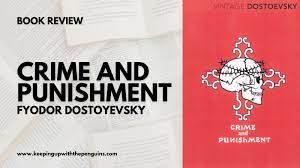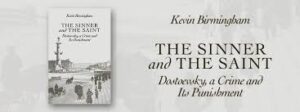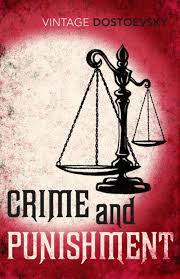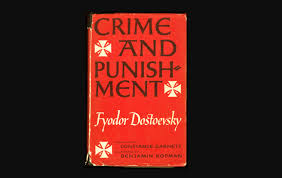Introduction

“Crime and Punishment” by Fyodor Dostoevsky is a profound exploration of morality, guilt, and redemption set against the backdrop of 19th-century Russia. Here’s a brief literary analysis of some key themes and elements in the novel:
Psychological Complexity
One of the most striking aspects of “Crime and Punishment” is its deep dive into the psyche of its protagonist, Rodion Raskolnikov. Dostoevsky intricately examines the internal struggles, moral conflicts, and psychological torment experienced by Raskolnikov as he grapples with the idea of committing murder and the subsequent guilt. This psychological depth adds layers of complexity to the narrative and allows readers to witness the intricate workings of the human mind.
Moral Dilemma and Existentialism
The novel explores profound moral dilemmas, particularly through Raskolnikov’s theory of the “extraordinary man” who is above conventional morality and capable of transcending societal norms for the greater good. However, as Raskolnikov commits the murder of the pawnbroker and her sister, he is plagued by guilt and existential crisis. Dostoevsky delves into existential themes, questioning the meaning of life, the nature of morality, and the consequences of one’s actions.
Religious and Philosophical Influences
Dostoevsky, deeply influenced by his Christian faith, weaves religious themes throughout the novel. Redemption, forgiveness, and the possibility of salvation are central motifs. Raskolnikov’s journey mirrors a spiritual awakening as he confronts his crimes and seeks redemption through confession and atonement. Additionally, Dostoevsky incorporates philosophical ideas from existentialism, utilitarianism, and nihilism, engaging with these schools of thought to explore the complexities of human existence.
Social Critique
Through its portrayal of 19th-century Russian society, “Crime and Punishment” offers a scathing critique of various social institutions such as the justice system, the church, and the class structure. Dostoevsky exposes the harsh realities of poverty, crime, and exploitation, highlighting the moral decay and spiritual bankruptcy of a society plagued by moral ambiguity and ethical relativism.
Characterization

Dostoevsky’s characters are richly drawn and multi-dimensional, reflecting the diversity of human experience. From the tormented Raskolnikov to the virtuous Sonia, each character embodies different facets of the human condition, contributing to the novel’s thematic depth and emotional resonance.
Symbolism and Imagery
The novel is replete with symbolism and imagery, enriching the narrative with layers of meaning. From the yellowed walls of the pawnbroker’s apartment to the recurring motif of crosses and religious iconography, Dostoevsky employs symbolism to convey deeper thematic resonances and evoke a sense of spiritual and moral significance.
Characterization:

Raskolnikov:
The protagonist, Raskolnikov, is a deeply conflicted character who embodies the struggle between intellect and morality. His intellectual superiority complex leads him to believe he is above conventional morality and capable of committing murder for a greater good. However, his guilt and inner turmoil reveal the limitations of his rationalization.
Sonia:
Sonia represents purity and redemption in the novel. As a prostitute who finds solace in her faith, she serves as a moral compass for Raskolnikov and helps lead him towards repentance and salvation.
Porfiry Petrovich:
The chief investigator, Porfiry, is portrayed as a shrewd and insightful figure who engages Raskolnikov in a battle of wits. He represents the forces of justice and psychological insight that eventually lead to Raskolnikov’s confession.
Themes:
Alienation and Isolation:
Raskolnikov’s intellectual detachment from society leads to his profound sense of alienation. His inability to connect with others exacerbates his inner turmoil and contributes to his eventual downfall.
Guilt and Redemption:
The novel explores the psychological effects of guilt and the possibility of redemption. Raskolnikov’s moral conscience torments him relentlessly until he ultimately confesses his crime and seeks redemption through suffering and repentance.
Power and Morality:
Raskolnikov’s belief in the extraordinary individual’s right to transgress conventional morality reflects Dostoevsky’s exploration of power dynamics and the ethical implications of nihilism.
Symbolism The Axe: The murder weapon, an axe, symbolizes Raskolnikov’s desperate attempt to assert power over his circumstances. It represents his belief in his own superiority and his willingness to commit a heinous act to prove his theory of the “extraordinary man.”
The Axe: The murder weapon, an axe, symbolizes Raskolnikov’s desperate attempt to assert power over his circumstances. It represents his belief in his own superiority and his willingness to commit a heinous act to prove his theory of the “extraordinary man.”
Sonia’s Cross: Sonia’s cross symbolizes faith, sacrifice, and redemption. It serves as a reminder of moral values and acts as a catalyst for Raskolnikov’s spiritual transformation.
Light and Darkness: Throughout the novel, Dostoevsky employs the contrast between light and darkness to represent moral clarity versus moral ambiguity. Raskolnikov’s journey from darkness to light parallels his moral awakening and eventual redemption.
Narrative Technique:
Dostoevsky employs a psychological realism that delves deeply into the inner workings of his characters’ minds. The novel is characterized by intense introspection and a shifting narrative perspective that allows readers to empathize with Raskolnikov’s inner turmoil.

Conclusion
Overall, “Crime and Punishment” stands as a timeless masterpiece of Russian literature, exploring universal themes of morality, guilt, and redemption with profound insight and psychological acuity. Dostoevsky’s magnum opus continues to captivate readers with its compelling characters, intricate narrative, and profound philosophical depth.


